
Beam Combination Boosts Power for Quantum Cascade Lasers
An efficient combination technique bundles the excellent beam qualities of MIR quantum cascade lasers to enable higher output powers.
TANGI LE GUENNIC, CAILABS, AND GRÉGORY MAISONS, MIRSENSE
Quantum cascade laser (QCL) sources offer a compelling option in the MIR range, but they currently deliver limited output power. This drawback is driving growing interest in methods that would allow QCLs to combine their beams passively and in a compact format to permit higher power outputs and to help integrate these sources in new applications.
Demand for MIR sources
There is significant market demand for high-performance laser sources in the MIR. The wavelengths in this range are
of particular scientific interest because they can be used to investigate the spectrometric response of various molecules, gases, and polluting elements in the atmosphere. In addition, biomedicine closely follows developments in the MIR to exploit similar absorption properties. These wavelengths are also widely used in the defense industry, which actively seeks portable laser sources in the 4- to 5-µm range to use as countermeasures to jam, blind, or even destroy the seeker head of guided missiles targeting aircraft and helicopters. Laser communications are yet another application area for MIR
components, since the atmosphere has transparent windows in this spectral band.
The key criteria for all of these applications are higher power, compactness, ease of use, and compatibility with harsh environments. The opportunity for QCLs that are able to accommodate these criteria is clear.
The case for QCLs
The main laser sources available in the MIR bands of interest are gas lasers, such as CO or CO2 systems. These deliver high power, but they are more compatible with applications requiring output in the range around 10 µm. Optical parametric oscillators are also used within this band, and they have the advantage of being wavelength-tunable. But they suffer from a lack of robustness and compactness.
Developed over the last 20 years, QCLs offer another option for coherent emission in the MIR. These semiconductor-based continuous-wave laser sources operate at room temperature across a wide range of infrared wavelengths. The technology
is mature, and it supports compact, off-the-shelf sources that offer intrinsic robustness, long lifetimes, and good stability. The far-field intensity distribution of QCLs is very close to the Gaussian distribution. These emitters also offer the possibility to work in pulsed mode across a wide range of frequencies, from the hertz to the gigahertz, and to pattern the emission over time to add modulations (for example, gating, sine, and ramp) or to define an arbitrary waveform.
QCL performance parameters
The current record for the average power output of a QCL source is 3 W at 4.6 µm, set in 20091. Select commercial QCLs currently offer outputs of around 1 to 2 W (Figure 1).
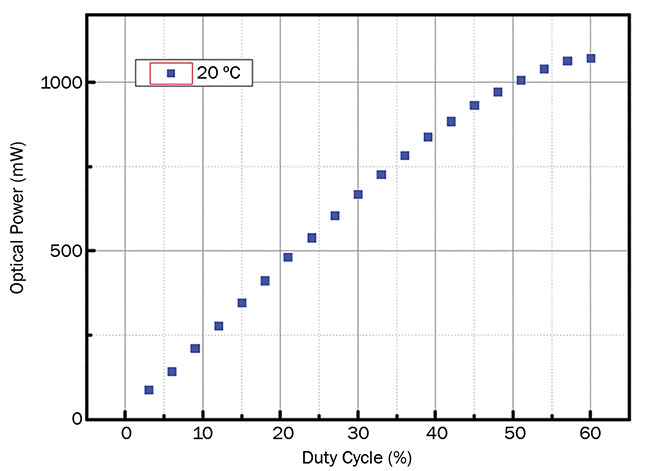
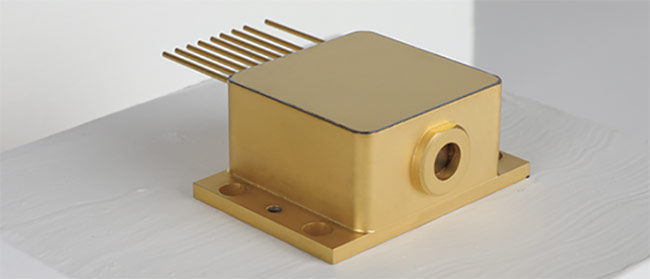
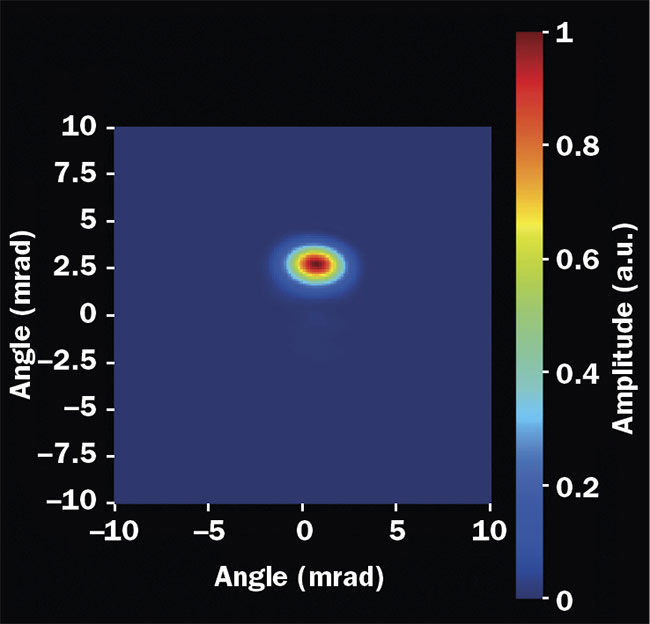
Figure 1. The evolution of average optical powers demonstrated by a quantum cascade laser (QCL) emitting at 4 µm, versus the duty cycle (top). A packaged QCL (middle). A QCL beam recorded with an infrared camera (bottom). Courtesy of mirSense.
High-power QCLs use a sealed package that is compliant with military standards for shock and vibration. Such high-heat load packages incorporate a Peltier element for thermal stabilization of the device and a collimating lens to ensure a low beam divergence — typically from 3 to 6 mrad horizontally and 2 to 4 mrad vertically.
However, some of these applications require more power. Providing superior stable power is very complicated with a single source. One potential solution involves combining the beams of several QCLs to form a single coherent beam that provides increased overall output power.
This is possible to achieve through either coherent or incoherent combination.
Coherent combination combines the output of several QCLs’ constructive interferences. Conversely, incoherent combination of laser beams is an additive superposition without interference of the beams, and thus it does not modify the light intensity distribution in the beam.
The advantage of incoherent combining is that it avoids the requirement for polarization, wavelength control, or input phasing, which represents the most complex part to achieve. It is therefore possible to combine QCL emissions by simply summing the intensity of the input beams. This greatly simplifies the optical architecture and overall control of the system.
This approach aims to provide high-efficiency beam combination without degrading the output beam. The important criteria for evaluating such a combination therefore include its efficiency, the quality of the output beam — generally defined by the M2 factor — and the number of combined sources involved.
Although coherent combination methods have been demonstrated2-4, incoherent methods are widely preferred due to their comparative robustness and compactness. Incoherent methods further include polarization combining, in which two beams of mutually orthogonal polarization states can be combined into a single beam with extremely high (>90%) efficiency, but this technique is limited to two beams5,6.
Spectral and space domains
Incoherent combining in the spectral domain is an attractive option because the center wavelength of the QCLs is not limited by material properties and can be set during their design. Spectrometers, such as grating couplers, are able to combine up to 15 beams with or without dispersion compensation in the low-power regime by using a distributed feedback QCL array4,7. Free-space optical devices using dichroic beamsplitters have also been developed to combine multiple QCL beams with a limited spacing of ~100 nm8,9.
It has been demonstrated that a QCL array coupled to an external resonator (EC-QCL) can produce a high-quality beam with an M2 under 2 and an efficiency of 50%8. However, thermal
effects and spectral requirements for the initial emitters impose a strict limit on the average power and duty cycle of the primary sources. More recently, the combination of four discrete QCLs arranged in such a geometry has achieved similar performance while mitigating some of the thermal issues. In summary, the temperature stability and difficulties in correctly aligning the component still make this a difficult combination technique to use.
Incoherent combining in the space domain also appears to be a viable option. Geometries, such as filling mosaic apertures with microlenses, have achieved
efficiencies close to 90%, with eight QCLs at the input, but the M2 in the fast axis has been estimated at 30, making them almost unusable8. Hollow waveguides combined with free-space dichroics have also been used to combine up to four sources with an overall efficiency of 75%, but no M2 measurements were reported9.
One other optimal solution is to use an incoherent combining technique based on multiplane light conversion (MPLC) technology. Invented in 2010, MPLC is a beam-shaping technique with a lossless modal approach (Figure 2).
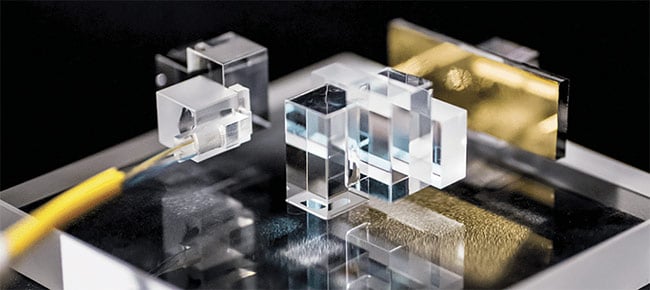
Figure 2. Multiplane light conversion (MPLC) technology arranged in a fibered input and free-space output configuration. Courtesy of Cailabs.
Theoretically, any unitary spatial transform can be implemented by a succession of transverse phase profiles separated by free-space propagation for optical Fourier transforms.
Using successive reflections on a single-phase plate separated by a specific propagation distance, MPLC enables the combination of multiple incoherent or coherent beams, thanks to its cavity — formed by a mirror and the reflective phase plate — implementing the successive phase profiles and optical transforms.
Unfortunately, it is not physically possible for incoherent combining methods to obtain a single single-mode output from a multimode input composed of several single-mode QCL sources. The incoherent combining of QCLs via MPLC consists of transforming a given number of single-mode lasers into the same number of lower-order Laguerre-Gaussian modes10 (Figure 3).
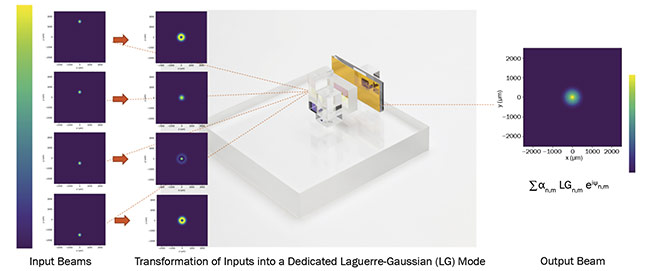
Figure 3. An example of a coherent combination of four laser beams. The transformation of each input targets a specific Laguerre-Gaussian mode by the MPLC device. Courtesy of Cailabs.
The unitarity of the transform ensures that there is no intrinsic loss in the mode conversion. Losses in MPLC only occur due to imperfect optical elements (for example, coating defects or imperfect phase plate manufacturing).
When all the QCL inputs are turned on, the MPLC component achieves optimal combining of incoherent sources by limiting beam divergence while ensuring optimal output beam quality, as measured by M2 (see table).
Variations in the Theoretical M2 and the Cumulated M2 According to the Number of Modes at the Combiner Input
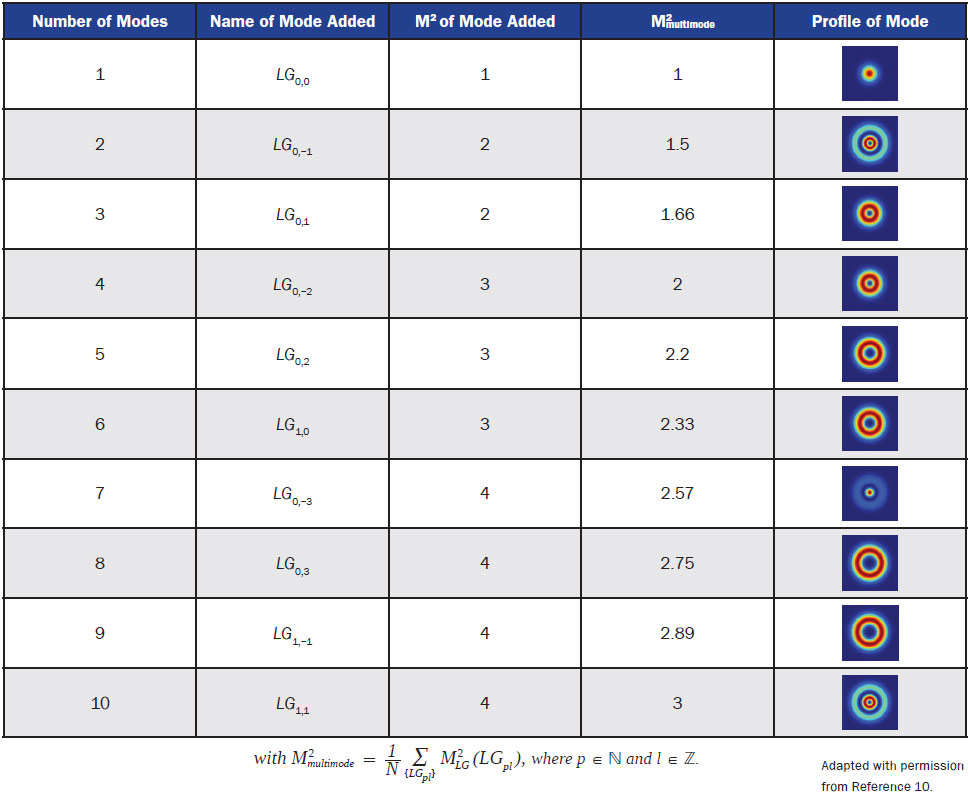
Combining QCLs with MPLC technology thus enables power outputs on the order of 10 W. A compact passive combiner is connected to a unit that houses the laser sources via single-mode optical fibers. This enables the electronics of the emission unit to be installed remotely, thus facilitating its integration. The beam can then be reworked at the output combiner to shape it to the desired dimensions.
Today, incoherent MPLC combiners are available off the shelf and have already made it possible to combine up to six fibered QCL inputs to achieve a combination efficiency of 72% and an experimental M2 of 3 to 3.5 at 4 µm (Figure 4).
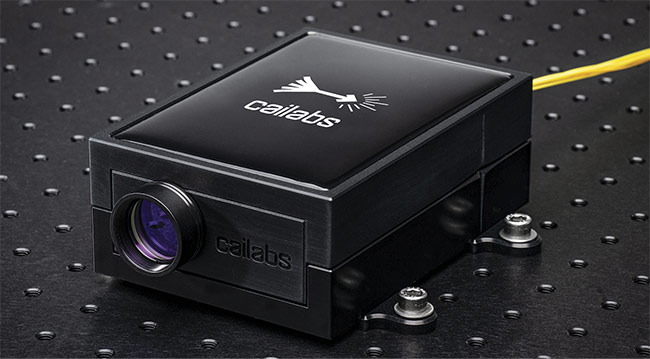
Figure 4. An incoherent MPLC combiner emitting at 4 µm — 153 × 125 × 55 mm. Courtesy of Cailabs.
Customization of this type of combiner is possible, and these systems will be able to cross an important gap to deliver more power for all applications required in the MIR wavelength range.
Meet the authors
Tangi Le Guennic is a project and product manager at Cailabs, where he is responsible for the development and commercialization of innovative optical solutions for PROTEUS and custom applications in defense, aeronautics, automotive, and biomedical; email: [email protected].
Grégory Maisons, Ph.D., has taken part in the development of novel quantum cascade laser devices for spectroscopy and chemical sensing. In his current role at mirSense, he pursues research and development of high-power emitters and single-frequency quantum cascade lasers, monolithically integrated new functionalities, and novel processing of diodes; email: [email protected].
References
1. A. Lyakh et al. (2009). 3 W continuous-wave room temperature single-facet emission from quantum cascade lasers based on nonresonant extraction design approach, Appl Phys Lett, Vol. 95, p. 141113.
2. G. Bloom et al. (2010). Coherent combining of two quantum-cascade lasers in a
Michelson cavity. Opt Lett, Vol. 35, Issue 11, pp. 1917-1919.
3. A. Lyakh et al. (2014). Continuous wave operation of buried heterostructure 4.6 µm quantum cascade laser Y-junctions and tree arrays. Opt Express, Vol. 22, Issue 1,
pp. 1203-1208.
4. G. Bloom et al. (2011). Passive coherent beam combining of quantum-cascade lasers with a Dammann grating. Opt Lett, Vol. 36, Issue 19, pp. 3810-3812.
5. S. Li et al. (2019). Incoherent polarization beam combination for mid-infrared semiconductor lasers. 14th National Conference on Laser Technology and Optoelectronics (LTO 2019), Vol. 11170. International
Society for Optics and Photonics.
6. B.G. Lee et al. (2009). Beam combining of quantum cascade laser arrays. Opt Express, Vol. 17, Issue 18, pp. 16216-16224.
7. A.K. Goyal et al. (2011). Dispersion-
compensated wavelength beam combining of quantum-cascade-laser arrays. Opt
Express, Vol. 19, Issue 27, pp. 26725-26732.
8. S. Hugger et al. (2010). Power scaling of quantum cascade lasers via multiemitter beam combining. Opt Eng, Vol. 49, Issue 11, pp. 111111.
9. I.F. Elder et al. (2016). Mid-IR laser source using hollow waveguide beam combining. Solid State Lasers XXV: Technology and Devices, Vol. 9726. International Society
for Optics and Photonics.
10. L. Garcia et al. (2017). Fast adaptive laser shaping based on multiple laser incoherent combining. SPIE Photonics West LASE, 10097-3.
/Buyers_Guide/Cailabs/c28390
/Buyers_Guide/mirSense/c31320
Published: September 2021
Glossary
- beamsplitter
- A beamsplitter is an optical device used to divide a beam of light into two or more separate beams, typically by reflecting a portion of the incident light while transmitting the remainder. Beamsplitters are widely used in various optical systems and applications, including microscopy, interferometry, laser systems, and telecommunications.
beamsplitter suppliers →
Beamsplitters can be classified into different types based on their operating principles and designs:
Plate...
FeaturesLasersquantum cascade lasersMIR Lasersspectroscopybeamsplitter